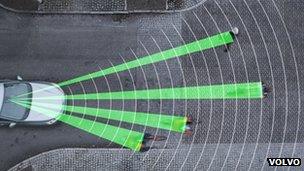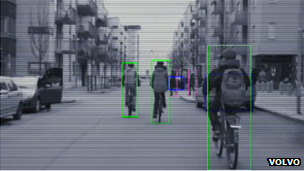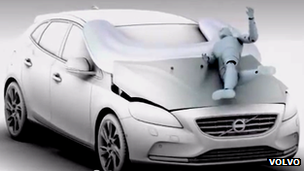Volvo unveils cyclist alert-and-brake car system
- Published

Volvo's system can handle multiple pedestrians and cyclists at the same time
Volvo has announced it is releasing a cyclist detection facility which should prevent fatal accidents.
The auto firm says vehicles fitted with the system will be able to detect threats including a cyclist suddenly swerving out into a car's path.
It said that if a collision risk was detected an alarm would sound and the car's brakes would be fully deployed.
However, safety campaigners say the tech is no replacement for caution behind the wheel.
The Chinese-owned company introduced the feature at the Geneva Motor Show.
No upgrades
The technology is an enhanced version of Volvo's pedestrian detection system which it launched in 2010.
Like the earlier release the innovation uses a radar in the car's grille and a camera located between its windscreen and back view mirror to detect collision threats.
The code which acts as the brains for the equipment has been rewritten to add the new feature, and its added complexity has meant a more powerful processor is now needed.

The new system involved a software rewrite and the addition of a faster processor
As a consequence Volvo cars fitted with prior versions of the product cannot simply install a software upgrade.
The firm added that the new system also needed to be installed while cars were being built in the factory - meaning it would have to be ordered up front - and it would be limited to seven out of 11 models in the company's current line-up.
Motorists wanting the feature face an added bill of at least £1,850 to buy it as a part of a package of added features.
Horse alerts
A Volvo Car UK spokesman told the BBC that the firm's engineers were now working on a fresh version as part of its 2020 programme which would also detect animals.
They have already spent an evening at a safari park where they laid out dried food to attract the creatures which they filmed to study their various behaviours.
"The aim is to avoid collisions with horses and deer for example," said Chris Mullord. "But there's no firm release date yet."
This is not the firm's only effort to protect people outside its vehicles from accidents. In May it will release its first car fitted with an airbag beneath its bonnet which will inflate if sensors in the front bumper detect they have come into contact with a cyclist or pedestrian.
The airbag covers approximately a third of the windscreen and is designed to minimise injury to the victim's head.

Volvo is also offering the option of an airbag under the bonnet of its V40 model
According to the UK's Department for Transport, external, 6,040 pedestrians, 3,270 cyclists and 5,440 motorcyclists were killed or seriously injured on the UK's roads between October 2011 and September 2012.
It said the figures for each category had increased by between 4-8% over the previous year.
British Cycling - the UK's governing body for cycling - said it appreciated Volvo's efforts, but added that they only addressed part of the problem.
"While we obviously welcome any safety measures that can be built into vehicles, people shouldn't be relying on technology to keep them and other road users safe," said a spokeswoman.
"What would make much more of a difference is making cyclist awareness a mandatory part of the driving test. British Cycling will continue to campaign for this as well as the establishment of a prominent, national cyclist awareness campaign similar to that we've seen for motorcyclists."
- Published14 February 2013
- Published17 October 2012
- Published25 January 2011